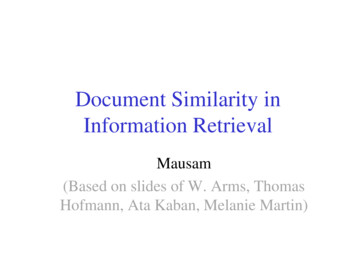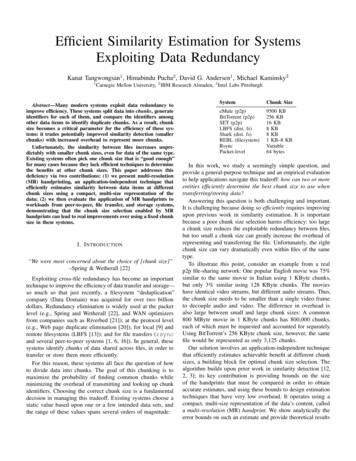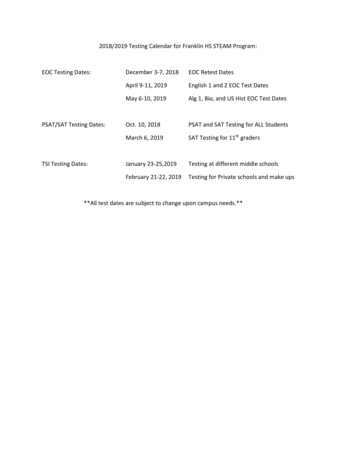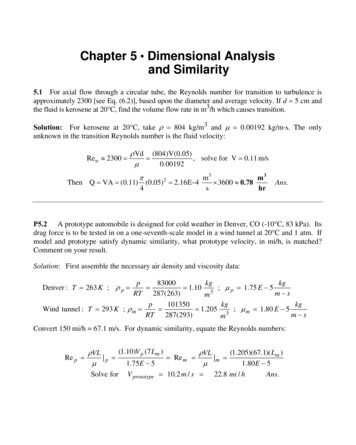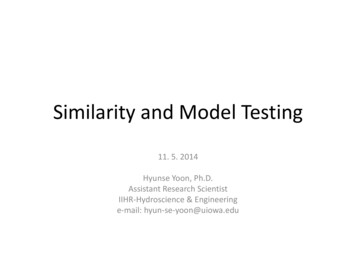
Transcription
Similarity and Model Testing11. 5. 2014Hyunse Yoon, Ph.D.Assistant Research ScientistIIHR-Hydroscience & Engineeringe-mail: hyun-se-yoon@uiowa.edu
Modeling Model: A representation of a physical system that may be used to predictthe behavior of the system in some desired respect Prototype: The physical system for which the predictions are to be made2
Types of Similarity Three necessary conditions for complete similarity between amodel and a prototype:1) Geometric similarity2) Kinematic similarity3) Dynamic similarity3
1) Geometric Similarity A model and prototype are geometrically similar if and only if all bodydimensions in all three coordinates have the same linear scale ratio.𝛼𝛼 𝐿𝐿𝑚𝑚 𝐿𝐿or, 𝜆𝜆 𝐿𝐿 𝐿𝐿𝑚𝑚 All angles are preserved in geometric similarity. All flow directions arepreserved. The orientation of model and prototype with respect to thesurroundings must be identical.4
2) Kinematic Similarity Kinematic similarity requires that the model and prototype have thesame length scale and the same time scale ratio. One special case is incompressible frictionless flow with no free surface.These perfect-fluid flows are kinematically similar with independentlength and time scales, and no additional parameters are necessary.5
2) Kinematic Similarity – Contd. Frictionless flows with a free are kinematically similar iftheir 𝐹𝐹𝐹𝐹 are equal:or𝑉𝑉𝑚𝑚2𝑉𝑉 2𝐹𝐹𝑟𝑟𝑚𝑚 𝐹𝐹𝐹𝐹𝑔𝑔𝐿𝐿𝑚𝑚 𝑔𝑔𝑔𝑔𝑉𝑉𝑚𝑚 𝑉𝑉1𝐿𝐿𝑚𝑚 2𝐿𝐿 𝛼𝛼 In general, kinematic similarity depends on theachievement of dynamic similarity if viscosity, surfacetension, or compressibility is important.6
Example 1: 𝐹𝐹𝐹𝐹 Similarity7
Example 1: 𝐹𝐹𝐹𝐹 Similarity – Contd.For 𝐹𝐹𝐹𝐹 similarity,Since 𝑄𝑄 𝐿𝑚𝑚 𝑉𝑉𝑉𝑉𝑚𝑚 𝑉𝑉 𝑔𝑔𝑔𝑔𝑄𝑄𝑚𝑚 𝑉𝑉𝑚𝑚 𝐴𝐴𝑚𝑚𝑉𝑉𝑚𝑚 ��𝐿𝑚𝑚 𝐴𝐴𝐿𝐿Thus, 𝑄𝑄𝑚𝑚 5𝛼𝛼 2 𝑄𝑄 125 12512 𝟏𝟏𝟓𝟓1 𝐴𝐴𝑚𝑚𝐴𝐴𝑚𝑚 𝛼𝛼 2𝐴𝐴𝐴𝐴2 𝛼𝛼 215𝑄𝑄𝑚𝑚1222 𝛼𝛼 𝛼𝛼 𝛼𝛼 𝑄𝑄2552𝐿𝐿𝑚𝑚 𝐿𝐿1𝛼𝛼 252𝟏𝟏 𝟑𝟑, 𝟏𝟏𝟏𝟏𝟏𝟏3000 𝟎𝟎. 𝟗𝟗𝟗𝟗 𝐦𝐦𝟑𝟑 /𝐬𝐬8
3) Dynamic Similarity Dynamic similarity exists when the model and the prototype have thesame length scale ratio (i.e., geometric similarity), time scale ratio (i.e.,kinematic similarity), and force scale (or mass scale) ratio. To be ensure of identical force and pressure coefficients between modeland prototype:1. Compressible flow: 𝑅𝑅𝑅𝑅 and 𝑀𝑀𝑀𝑀 are equal2. Incompressible flow:a. With no free surface: 𝑅𝑅𝑅𝑅 are equalb. With a free surface: 𝑅𝑅𝑅𝑅 and 𝐹𝐹𝐹𝐹 are equalc. If necessary, 𝑊𝑊𝑊𝑊 and 𝐶𝐶𝐶𝐶 are equal9
Theory of Models Flow conditions for a model test are completely similar if all relevant dimensionlessparameters have the same corresponding values for the model and then prototype. For prototype: For model:Similarity requirement*Prediction equationΠ1 𝜙𝜙 Π2 , Π3 , , Π𝑛𝑛Π1𝑚𝑚 𝜙𝜙 Π2𝑚𝑚 , Π3𝑚𝑚 , , Π𝑛𝑛𝑚𝑚Π2𝑚𝑚 Π2Π3𝑚𝑚 Π3 Π𝑛𝑛𝑛𝑛 Π𝑛𝑛Π1 Π1𝑚𝑚*Also referred as the model designconditions or modeling laws.10
Example 2: 𝑅𝑅𝑅𝑅 SimilarityDrag measurements were taken for a 5-cm diameter sphere in water at 20 Cto predict the drag force of a 1-m diameter balloon rising in air withstandard temperature and pressure. Determine (a) the sphere velocity if theballoon was rising at 3 m/s and (b) the drag force of the balloon if theresulting sphere drag was 10 N. Assume the drag 𝐷𝐷 is a function of thediameter 𝑑𝑑, the velocity 𝑉𝑉, and the fluid density 𝜌𝜌 and kinematic viscosity 𝜈𝜈.𝑑𝑑𝑚𝑚 0.05 m𝐷𝐷𝑚𝑚 10 N at 𝑉𝑉𝑚𝑚 ?watermodel𝐷𝐷 𝑓𝑓 𝑑𝑑, 𝑉𝑉, 𝜌𝜌, 𝜈𝜈𝑑𝑑 1 mairprototype𝐷𝐷 ? at 𝑉𝑉 3 m/s11
Example 2: 𝑅𝑅𝑅𝑅 Similarity – Contd. Dimensional analysis Similarity requirement Prediction equation𝐷𝐷𝑉𝑉𝑉𝑉 𝜙𝜙𝜌𝜌𝑉𝑉 2 𝑑𝑑 2𝜈𝜈𝑉𝑉𝑉𝑉 𝑉𝑉𝑚𝑚 𝑑𝑑𝑚𝑚 𝜈𝜈𝑚𝑚𝜈𝜈𝐷𝐷𝐷𝐷𝑚𝑚 2𝜌𝜌𝑉𝑉 2 𝑑𝑑 2 𝜌𝜌𝑚𝑚 𝑉𝑉𝑚𝑚2 𝑑𝑑𝑚𝑚12
Example 2: 𝑅𝑅𝑅𝑅 Similarity – Contd.(a) From the similarity requirement:or𝑉𝑉𝑉𝑉 𝑉𝑉𝑚𝑚 𝑑𝑑𝑚𝑚 𝜈𝜈𝑚𝑚𝜈𝜈𝑉𝑉𝑚𝑚 𝜈𝜈𝑚𝑚𝜈𝜈1.004 10 6 m2 s 1.45 10 5 m2 s𝑑𝑑𝑉𝑉𝑑𝑑𝑚𝑚1m0.05 m3 m s 𝑉𝑉 4.15 m s13
Example 2: 𝑅𝑅𝑅𝑅 Similarity – Contd.(b) From the prediction equation:or𝐷𝐷𝐷𝐷𝑚𝑚 2𝜌𝜌𝑉𝑉 2 𝑑𝑑 2 𝜌𝜌𝑚𝑚 𝑉𝑉𝑚𝑚2 𝑑𝑑𝑚𝑚𝜌𝜌𝐷𝐷 𝜌𝜌𝑚𝑚1.23 kg m3 998 kg m3𝑉𝑉𝑉𝑉𝑚𝑚23 m s4.15 m 𝑠𝑠𝑑𝑑𝑑𝑑𝑚𝑚2 𝐷𝐷 2.6 N2𝐷𝐷𝑚𝑚1m0.05 m210 N14
Example 3PropertyDiameter, 𝐷𝐷Angular velocity, 𝜔𝜔Flow rate, 𝑄𝑄FluidModelPrototype8 in.12 in.40π rad/s60π rad/s?6 ft3/swaterwater15
Example 3 – Contd. Dimensional analysisΔ𝑝𝑝𝑀𝑀𝐿𝐿 1 𝑇𝑇 2𝐷𝐷𝐿𝐿𝜔𝜔𝜌𝜌𝑇𝑇 1𝑄𝑄𝑀𝑀𝐿𝐿 3𝐿𝐿3 𝑇𝑇 1𝑟𝑟 𝑛𝑛 𝑚𝑚 5 3 2𝑚𝑚 3 repeating variables: 𝐷𝐷 for 𝐿𝐿, 𝜔𝜔 for 𝑇𝑇, and 𝜌𝜌 for 𝑀𝑀Π1 𝐷𝐷𝑎𝑎 𝜔𝜔𝑏𝑏 𝜌𝜌𝑐𝑐 Δ𝑝𝑝 ̇ 𝐿𝐿 ̇ 𝐿𝐿(𝑎𝑎 3𝑐𝑐 1) 𝑇𝑇 Π1 𝐷𝐷 2𝑎𝑎𝑇𝑇 1 𝑏𝑏 2𝜔𝜔𝑀𝑀 2 1𝜌𝜌𝑏𝑏𝑀𝑀𝐿𝐿 3𝑐𝑐 1𝑐𝑐𝑀𝑀𝐿𝐿 1 𝑇𝑇 2 ̇ 𝐿𝐿0 𝑇𝑇 0 𝑀𝑀0Δ𝑝𝑝Δ𝑝𝑝 𝜌𝜌𝜔𝜔 2 𝐷𝐷216
Example 3 – Contd. Dimensional analysis – contd.Π2 𝐷𝐷 𝑎𝑎 𝜔𝜔𝑏𝑏 𝜌𝜌𝑐𝑐 𝑄𝑄 ̇ 𝐿𝐿 ̇ 𝐿𝐿(𝑎𝑎 3𝑐𝑐 3) 𝑇𝑇 Dimensionless eq. Π2 𝐷𝐷𝑎𝑎𝑇𝑇 1 𝑏𝑏 1 3𝜔𝜔𝑏𝑏𝑀𝑀𝐿𝐿 3𝑐𝑐𝐿𝐿3 𝑇𝑇 1𝑀𝑀𝑐𝑐 ̇ 𝐿𝐿0 𝑇𝑇 0 𝑀𝑀0 1𝑄𝑄𝑄𝑄 𝜔𝜔𝐷𝐷 3Δ𝑝𝑝𝑄𝑄 𝜙𝜙𝜌𝜌𝜔𝜔 2 𝐷𝐷2𝜔𝜔𝐷𝐷317
Example 3 – Contd. Similarity requirementor𝑄𝑄𝑄𝑄𝑚𝑚 3𝜔𝜔𝐷𝐷3 𝜔𝜔𝑚𝑚 𝐷𝐷𝑚𝑚𝜔𝜔𝑚𝑚𝑄𝑄𝑚𝑚 𝜔𝜔40𝜋𝜋 rad s 60𝜋𝜋 rad s𝐷𝐷𝑚𝑚𝐷𝐷8 in.12 in.33𝑄𝑄6 ft 3 s 𝑄𝑄𝑚𝑚 1.19 ft 3 s18
Example 3 – Contd. Prediction equationΔ𝑝𝑝Δ𝑝𝑝𝑚𝑚 2 2𝜌𝜌𝜔𝜔 2 𝐷𝐷2 𝜌𝜌𝑚𝑚 �� 𝜌𝜌𝑚𝑚 1𝜔𝜔𝜔𝜔𝑚𝑚60𝜋𝜋 rad s40𝜋𝜋 rad s22𝐷𝐷𝐷𝐷𝑚𝑚12 in.8 in.5.522Δ𝑝𝑝𝑚𝑚1.195.5 𝑝𝑝𝑝𝑝𝑝𝑝 Δ𝑝𝑝 27.8 𝑝𝑝𝑝𝑝𝑝𝑝19
Distorted Models It is not always possible to satisfy all the known similarityrequirements. Models for which one or more similarity requirements are notsatisfied are called “distorted models.”20
Model Testing in Water(with a free surface) Geometric similarity 𝐹𝐹𝐹𝐹 similarity 𝑅𝑅𝑅𝑅 𝐿𝐿𝑚𝑚 𝛼𝛼𝐿𝐿 𝑉𝑉𝑚𝑚 𝐿𝐿𝑚𝑚 𝑉𝑉𝑉𝑉 𝜈𝜈𝑚𝑚𝜈𝜈𝑉𝑉 𝑔𝑔𝑔𝑔 𝐿𝐿𝑚𝑚𝑉𝑉𝑚𝑚 𝑉𝑉𝐿𝐿1/2 𝛼𝛼3𝜈𝜈𝑚𝑚 𝐿𝐿𝑚𝑚 𝑉𝑉𝑚𝑚 𝛼𝛼 𝛼𝛼 𝛼𝛼 2𝜈𝜈𝐿𝐿 𝑉𝑉21
Example 422
Example 4 – Contd. For water at atmospheric pressure and at 𝑇𝑇 15.6 C, the prototypekinematic viscosity is 𝜈𝜈 1.12 10-6 m2/s. Required kinematic viscosity of model liquid: 𝜈𝜈𝑚𝑚 3𝜈𝜈𝛼𝛼 2 1.12 10 6110032 1.12 10 9 m2 sEven liquid mercury has a kinematic viscosity of order 10-7 m2/s – still two ordersof magnitude too large to satisfy the dynamic similarity. In addition, it would betoo expensive and hazardous to use in this model test.23
Model Testing in Water – Contd.(with a free surface)Alternatively, by keeping 𝜈𝜈𝑚𝑚 𝜈𝜈, 𝑅𝑅𝑅𝑅 similarity𝐹𝐹𝐹𝐹 similarity𝑉𝑉𝑚𝑚𝑔𝑔𝑚𝑚 𝐿𝐿𝑚𝑚𝑉𝑉𝑚𝑚 𝐿𝐿𝑚𝑚 𝑉𝑉𝑉𝑉 𝜈𝜈𝜈𝜈𝑚𝑚 𝑉𝑉𝑔𝑔𝑔𝑔For example, for 𝛼𝛼 1/100, 𝑔𝑔𝑚𝑚𝑉𝑉𝑚𝑚 𝑔𝑔𝑉𝑉𝑔𝑔𝑚𝑚1 𝑔𝑔100 Again, impossible to achieve.𝑉𝑉𝑚𝑚𝐿𝐿 𝛼𝛼 1𝐿𝐿𝑚𝑚𝑉𝑉 32𝐿𝐿 𝛼𝛼 2 𝛼𝛼 1 𝛼𝛼 3𝐿𝐿𝑚𝑚 1 10624
Model Testing in Water – Contd.(with a free surface) In practice, water is used for both the model and the prototype, and the𝑅𝑅𝑅𝑅 similarity is unavoidably violated. The low-𝑅𝑅𝑅𝑅 model data are used to estimate by extrapolation the desiredhigh-𝑅𝑅𝑅𝑅 prototype data. There is considerable uncertainty in using extrapolation, but no otherpractical alternative in model testing.25
Model Testing in Water – Contd.(with a free surface: Ship model testing) Assume:𝐶𝐶𝑇𝑇 𝑓𝑓 𝑅𝑅𝑅𝑅, 𝐹𝐹𝐹𝐹 𝐶𝐶𝑤𝑤 𝐹𝐹𝐹𝐹 𝐶𝐶𝑣𝑣 𝑅𝑅𝑅𝑅 𝐶𝐶𝑇𝑇 Total resistance coefficient 𝐶𝐶𝑊𝑊 Wave resistance coefficient 𝐶𝐶𝑣𝑣 Viscous friction resistance coefficientModel Testing with the 𝐹𝐹𝐹𝐹 similarity𝐶𝐶𝑤𝑤 𝐶𝐶𝑤𝑤𝑤𝑤 𝐶𝐶𝑇𝑇𝑇𝑇 𝐶𝐶𝑣𝑣𝑣𝑣Extrapolation (with 𝐶𝐶𝑤𝑤𝑤𝑤 𝐶𝐶𝐶𝐶)𝐶𝐶𝑇𝑇 𝐶𝐶𝑤𝑤 𝐶𝐶𝑣𝑣 𝐶𝐶𝑇𝑇𝑇𝑇 𝐶𝐶𝑣𝑣𝑣𝑣 𝐶𝐶𝑣𝑣𝐶𝐶𝑣𝑣𝑣𝑣 𝑅𝑅𝑒𝑒𝑚𝑚 and 𝐶𝐶𝑣𝑣 𝑅𝑅𝑅𝑅 obtained from flat plate data with samesurface area of the model and the proto type, respectively.26
Model Testing in Air Geometric similarity: 𝑀𝑀𝑀𝑀 similarity: 𝑅𝑅𝑅𝑅 similarity:𝑉𝑉𝑚𝑚 𝑉𝑉 𝑎𝑎𝑚𝑚 𝑎𝑎𝐿𝐿𝑚𝑚 𝑉𝑉𝑚𝑚 𝐿𝐿𝐿𝐿 𝜈𝜈𝑚𝑚𝜈𝜈 𝐿𝐿𝑚𝑚 𝛼𝛼𝐿𝐿 𝑉𝑉𝑚𝑚 𝑎𝑎𝑚𝑚 𝑉𝑉𝑎𝑎𝜈𝜈𝑚𝑚 𝐿𝐿𝑚𝑚 𝑉𝑉𝑚𝑚𝑎𝑎𝑚𝑚 𝛼𝛼 𝜈𝜈𝐿𝐿 𝑉𝑉𝑎𝑎 Since the prototype is an air operation, need a model fluid of low viscosityand high speed of sound, e.g., hydrogen – too expensive and danger. 𝑅𝑅𝑅𝑅 similarity is commonly violated in wind tunnel testing.27
Example 528
Example 5 – Contd. or𝑅𝑅𝑅𝑅 similarity:𝑉𝑉𝑚𝑚 since 𝐿𝐿𝑚𝑚 𝐿𝐿 1/10. If 𝜈𝜈𝑚𝑚 𝜈𝜈 1, Also, if 𝑉𝑉 55 mph,𝜈𝜈𝑚𝑚𝜈𝜈𝑉𝑉𝑚𝑚 𝐿𝐿𝑚𝑚 𝑉𝑉𝑉𝑉 ��𝑉 10𝑉𝑉𝜈𝜈𝐿𝐿𝑚𝑚𝑉𝑉𝑚𝑚 10𝑉𝑉𝑉𝑉𝑚𝑚 550 mph Too large for simple tests. In addition, 𝑀𝑀𝑀𝑀 0.7 for the model and thecompressibility effects become important while they are not for the prototypewith 𝑀𝑀𝑀𝑀 0.07. We will need 𝜈𝜈𝑚𝑚 𝜈𝜈 1 for more realistic 𝑉𝑉𝑚𝑚 .29
Example 5 – Contd. 𝜈𝜈 variation with 𝑇𝑇 for air at standard atmospheric pressure (scaled with 𝜈𝜈at 10 C): Thus, it would be better to have a colder wind tunnel. However, even with𝑇𝑇 -40 C, which gives 𝜈𝜈𝑚𝑚 𝜈𝜈 0.707, the required 𝑉𝑉𝑚𝑚 10(0.707)(55) 389 mph.30
Model Testing in Air – Contd. In practice, wind tunnel tests are performed at several speeds near themaximum operating speed, and then extrapolate the results to the fullscale Reynolds number. While drag coefficient 𝐶𝐶𝐷𝐷 is a strong function of Reynolds number at lowvalues of 𝑅𝑅𝑅𝑅, for flows over many objects (especially “bluff” objects), theflow is Reynolds number independent above some threshold value of 𝑅𝑅𝑅𝑅.31
Example 6𝐹𝐹𝐷𝐷 𝜌𝜌𝜌𝜌𝜌𝜌 𝜙𝜙12 𝐴𝐴𝜇𝜇𝜌𝜌𝑉𝑉2𝑊𝑊 Width of the truck𝐴𝐴 Frontal area32
Example 6 – Contd.𝑅𝑅𝑒𝑒𝑚𝑚𝑅𝑅𝑅𝑅 ��𝜇 𝜌𝜌𝑚𝑚 𝑉𝑉𝑚𝑚 𝑊𝑊𝑚𝑚𝜇𝜇𝑚𝑚 kg kgm1.184 3 26.80.159 msm1.849 10 5 kg s/mm1.184 3 26.816 0.159 msm1.849 10 5 kg s/m 7.13 105 4.37 106Reynolds number independence is achieved for 𝑅𝑅𝑅𝑅 5.5 105 , thus𝐶𝐶𝐷𝐷 12𝐹𝐹𝐷𝐷𝜌𝜌𝑉𝑉 2 𝐴𝐴12 𝐶𝐶𝐷𝐷𝐷𝐷 0.76 from the wind tunnel data 𝐹𝐹𝐷𝐷 𝜌𝜌𝑉𝑉 2 𝐴𝐴 𝐶𝐶𝐷𝐷 12kg1.184 3m 3.4 𝑘𝑘Nm 226.8s162 0.159m 0.257m 0.7633
Similarity and Model Testing 11. 5. 2014 . Hyunse Yoon, Ph.D. Assistant Research Scientist . IIHR-Hydroscience & Engineering . e-mail: hyun-se-yoon@uiowa.edu
